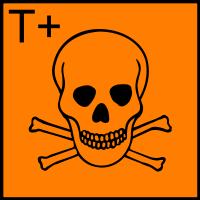|
Storage Condition
|
|
Refrigerator, Under Inert Atmosphere
|
 Show
data source Show
data source
|
|
Room Temperature (15-30°C), Desiccate, Store Under Nitrogen
|
 Show
data source Show
data source
|
|
|
Storage Warning
|
|
Highly Flammable/Very Toxic/Corrosive/Moisture Sensitive/Store under Argon
|
 Show
data source Show
data source
|
|
Moisture Sensitive
|
 Show
data source Show
data source
|
|
|
European Hazard Symbols
|
 Flammable (F) Flammable (F)
|
 Show
data source Show
data source
|
 Nature polluting (N) Nature polluting (N)
|
 Show
data source Show
data source
|
 Toxic (T) Toxic (T)
|
 Show
data source Show
data source
|
 Highly toxic (T+) Highly toxic (T+)
|
 Show
data source Show
data source
|
|
|
UN Number
|
|
1992
|
 Show
data source Show
data source
|
|
2922
|
 Show
data source Show
data source
|
|
3179
|
 Show
data source Show
data source
|
|
UN3134
|
 Show
data source Show
data source
|
|
|
MSDS Link
|
|
|
German water hazard class
|
|
3
|
 Show
data source Show
data source
|
|
|
Hazard Class
|
|
3
|
 Show
data source Show
data source
|
|
4.1
|
 Show
data source Show
data source
|
|
4.3
|
 Show
data source Show
data source
|
|
6.1
|
 Show
data source Show
data source
|
|
8
|
 Show
data source Show
data source
|
|
|
Packing Group
|
|
2
|
 Show
data source Show
data source
|
|
II
|
 Show
data source Show
data source
|
|
|
Australian Hazchem
|
|
2X
|
 Show
data source Show
data source
|
|
|
Risk Statements
|
|
11-15-26/27/28-32-34-50/53
|
 Show
data source Show
data source
|
|
11-19-23/24/25-32-36/37/38-50/53
|
 Show
data source Show
data source
|
|
26/27/28-32-34-50/53
|
 Show
data source Show
data source
|
|
R:10-25
|
 Show
data source Show
data source
|
|
|
Safety Statements
|
|
16-26-36/37-45-61
|
 Show
data source Show
data source
|
|
26-28-36/37/39-43-45-61
|
 Show
data source Show
data source
|
|
26-28-36/37/39-45-60-61
|
 Show
data source Show
data source
|
|
26-28-36/37/39-45-61
|
 Show
data source Show
data source
|
|
S:16-28-29-36/37/39-45
|
 Show
data source Show
data source
|
|
|
EU Classification
|
|
FT2
|
 Show
data source Show
data source
|
|
|
EU Hazard Identification Number
|
|
4.1B
|
 Show
data source Show
data source
|
|
|
Emergency Response Guidebook(ERG) Number
|
|
134
|
 Show
data source Show
data source
|
|
|
TSCA Listed
|
|
是
|
 Show
data source Show
data source
|
|
|
EU Index
|
|
not listed
|
 Show
data source Show
data source
|
|
|
GHS Pictograms
|

|
 Show
data source Show
data source
|

|
 Show
data source Show
data source
|

|
 Show
data source Show
data source
|

|
 Show
data source Show
data source
|
|
|
GHS Signal Word
|
|
Danger
|
 Show
data source Show
data source
|
|
|
NFPA704
|
|
|
 Show
data source Show
data source
|
|
|
GHS Hazard statements
|
|
H225-H301-H311-H314-H330-H335-H400-H411
|
 Show
data source Show
data source
|
|
H228-H260-H300-H310-H314-H330-H410
|
 Show
data source Show
data source
|
|
H228-H261-H300-H310-H330-H314-H318-H400-H410
|
 Show
data source Show
data source
|
|
H300-H310-H314-H330-H410
|
 Show
data source Show
data source
|
|
|
GHS Precautionary statements
|
|
P210-P223-P231 + P232-P260-P370 + P378-P422
|
 Show
data source Show
data source
|
|
P210-P260-P273-P280-P284-P301 + P310
|
 Show
data source Show
data source
|
|
P210-P301+P310-P303+P361+P353-P304+P340-P305+P351+P338-P320-P330-P361-P405-P501A
|
 Show
data source Show
data source
|
|
P260-P264-P273-P280-P284-P301 + P310
|
 Show
data source Show
data source
|
|
|
Personal Protective Equipment
|
|
Eyeshields, Faceshields, full-face particle respirator type N100 (US), Gloves, respirator cartridge type N100 (US), type P1 (EN143) respirator filter, type P3 (EN 143) respirator cartridges
|
 Show
data source Show
data source
|
|
|
RID/ADR
|
|
UN 1992 3/PG 2
|
 Show
data source Show
data source
|
|
UN 2922 8/PG 2
|
 Show
data source Show
data source
|
|
UN 3179 4.1/PG 2
|
 Show
data source Show
data source
|
|
|
Supplemental Hazard Statements
|
|
Contact with acids liberates very toxic gas.
|
 Show
data source Show
data source
|
|
Contact with acids liberates very toxic gas., May form explosive peroxides.
|
 Show
data source Show
data source
|
|